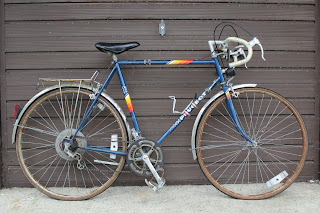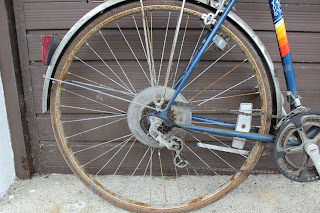RALEIGH DYNA-TECH
The bonded frame experiment from the late 80s that didn't really work!
It all sounds great in theory. Let's make a new bike frame without brazing, the conventional way. Let's make aluminium cast lugs, add a variety of tube materials like Cr-Mo, Titanium, aluminium, metal matrix to build up a range. Now, we can't weld different materials together so let's bond them. The heat weakens the frame anyway. This new concept of manufacture will change the whole industry. Well, as you can imagine, it didn't. The serial number dates this frame to 1990.
Who would think of doing this? Well, bonded bike frames had been around for quite some time, the French manufacturer Vitus had successfully done it in the late 70s and high profile professionals like Sean Kelly actually won races on them in the mid 80s. The concept is simple, make alloy lugs, use alloy, steel or carbon tubes and bond them together. It does away with brazing, a method where high temperatures are used at the joints, in turn weakening the steel in those areas. Well, I have never personally cracked a steel frame that was brazed. I cracked forks at the crown from doing wheelies. I know, road bikes are not designed for wheelies! A BMX is for that kind of thing.
In the late 80s things started to change in the bike manufacturing world and companies like Raleigh felt the pressure to develop new products. The bicycle industry was in a bit of a decline, there was lots of competition from the far east too. Mountain bikes were the big thing back then and the casual rider often came away from a bike shop with a heavy metal monster with big fat tyres and 21 gears. It could climb any hill but it never had the finesse of a proper road bike. Even a Raleigh 501 road bike was miles better and more comfortable than these clunky elephants, but that was the way the industry was going. On the other hand there was some high-end MTBs that are certainly very nice but these were for the off-roaders, the trail-blazers, and hey, there's nothing wrong with that, in fact it's great fun on a great MTB, but not the low-end steel deadweight, that's really for going to the cornershop for the paper or picking blackberries in summer. Funny how the 80s started with the BMX and ended with the MTB!

Where was I? Oh, yes Dyna-Tech, they were made by the Special Products Division, Nottingham, England, and went into production around 1990, don't quote me, just look on-line and you will be pretty disappointed with the lack of information on these machines. There's a lot of talk on the forums, a good few pictures, but apart from the odd brochure in pdf, you can forget it. There is no official site, figures, dates of manufacture or statistics simply because around the mid to late 90s when Raleigh was sold off and taken over and then went bang or whatever happens to once great British companies. Today the Raleigh badge is slapped onto generic crap in a box from the Far East. No disrespect, but to me personally, Raleigh of Nottingham was a solid part of my boyhood years, a reassuring comfort through thick and thin of teenage insecurity and the best of British bicycle engineering. Of course you had lots of other British manufacturers that made the high end racing machines, but they were far out of the reach of the average boy and girl that liked to cycle.
How did I discover these bikes? I was combing through an online advertising site that I spend a lot of time watching stuff on, particularly bikes and I saw a Raleigh M-Trax 600, MTB Cr-Mo/Titanium Duo-Tech I was drawn to. (that bike is featured elsewhere in my blog), I went and looked at it and immediately loved it after a test ride and bought it on the spot. Why did I buy a Dyna-Tech road bike? Why? Even after reading what little there is to know. Reading that they de-bonded. That they crack. That they were a failure. I bought it out of sheer curiosity. The MTB didn't de-bond after cycling it everyday for nearly two months. It's a pretty light, it's dinger and I'm proud of it and
if it was stolen or smashed I would buy another.
Shimano Exage 500EX Rear Derailleur
Shimano Exage 500EX with BioPace Rings 52/42
Shimano Exage 500EX Dual Pivot
Shimano Exage 500EX Levers (rattless type!)
Reynolds Cr-Mo Fork Blades
Shimano PDA550 pedals with nylon toeclips

SR Seat Tube

Where was I? Oh, yes Dyna-Tech, they were made by the Special Products Division, Nottingham, England, and went into production around 1990, don't quote me, just look on-line and you will be pretty disappointed with the lack of information on these machines. There's a lot of talk on the forums, a good few pictures, but apart from the odd brochure in pdf, you can forget it. There is no official site, figures, dates of manufacture or statistics simply because around the mid to late 90s when Raleigh was sold off and taken over and then went bang or whatever happens to once great British companies. Today the Raleigh badge is slapped onto generic crap in a box from the Far East. No disrespect, but to me personally, Raleigh of Nottingham was a solid part of my boyhood years, a reassuring comfort through thick and thin of teenage insecurity and the best of British bicycle engineering. Of course you had lots of other British manufacturers that made the high end racing machines, but they were far out of the reach of the average boy and girl that liked to cycle.
How did I discover these bikes? I was combing through an online advertising site that I spend a lot of time watching stuff on, particularly bikes and I saw a Raleigh M-Trax 600, MTB Cr-Mo/Titanium Duo-Tech I was drawn to. (that bike is featured elsewhere in my blog), I went and looked at it and immediately loved it after a test ride and bought it on the spot. Why did I buy a Dyna-Tech road bike? Why? Even after reading what little there is to know. Reading that they de-bonded. That they crack. That they were a failure. I bought it out of sheer curiosity. The MTB didn't de-bond after cycling it everyday for nearly two months. It's a pretty light, it's dinger and I'm proud of it and
if it was stolen or smashed I would buy another.
I saw this Dyna-Tech 400 on the adverts site and asked to see it. The 400 was the entry level machine with Cr-Mo tubes bonded to aluminium lugs. The seller agreed and I met up with him. On inspection it was a bit grubby but there was no visible damage or cracks on the frame. There was a bit of paint flaking from the right rear chain stay behind the chain rings. I examined this and if it was rotted through I would sadly have to walk away, but there is no point buying a crippled duck. I took a small spin and there was no wobbling or creaking. I beat the seller down on the price by 20% we shook hands and I pulled the wheels off and piled it into the car in three pieces! Once I got it home I started to dismantle it. It needed a good clean. I worked on it for almost four hours, bringing back the shine it once boasted back in the early 90s. The wheels were in very good condition for their age. I took it for a ten mile run, it was lively and smooth but I noticed a lot of rattle from the brake levers, it was very annoying, ruining my spin and a priority fix once back to the workshop. I curbed this by shooting in a little wood glue to stop it and it worked. There was a strange rattle in the rear rim and after a thorough examination I found a spoke nipple hiding in there! Once it was removed the wheel returned to silent running.
The final outcome after a bit of work. New bar tape. The two brake cables and the two gear cables replaced. I decided to resprayed the rear stays after sanding off the rust. I masked the rest of the frame in pages from an old telephone directory an sprayed on four layers of silver and three layers of lacquer from cans and it looks pretty good.
Shimano Exage 500EXShimano Exage 500EX Rear Derailleur
Shimano Exage 500EX with BioPace Rings 52/42
Shimano Exage 500EX Dual Pivot
Shimano Exage 500EX Levers (rattless type!)
Reynolds Cr-Mo Fork Blades
Shimano Hubs but unstamped with name.
Alesa RimsShimano PDA550 pedals with nylon toeclips
SR Stem and Road Custom Handlebar

SR Seat Tube
Head tube aluminium lugs with mitred Cr-Mo tubes
Aluminium sear clamp with bolt-in rear steel stays.
So what's it like to ride? It's bloody good actually, while not as light as my other Raleigh 501 bikes it certainly has a lot of whip and goes like shit off a shovel. One thing I do notice in comparison to my Raleigh Elan 501 and that is, regardless of it's tighter frame geometry, it seems to die a bit on hills but on the flat acceleration is quite noticeable with plenty torque under feet. It is very smooth, the gears are silky and you can hardly hear them change. I have rode it almost now for almost eight days in a row and I am growing very fond of it. The next step is to put Shimano clipless pedals on and then it may reveal it's full potential. So what do I think of the whole Dyna-Tech concept? After discovering this machine, buying it, servicing it and riding it nearly two hundred miles in just over a week, in an age of mass produced Taiwanese alloy clones, amazing hi-tech carbon, over-rated and overpriced 'ubermaschines' I think Dyna-Tech is not a bad idea at really. Try one, you may fall in love with cycling all over again!


























































